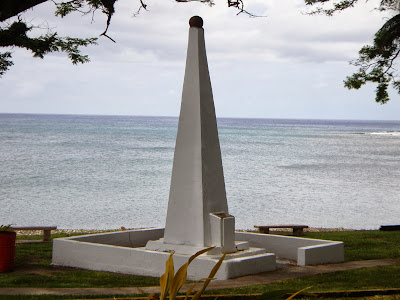Magellan's Entrails
Senator Tommy Morrison recently introduced Bill 238, which
would reinstate Discovery Day as a local Government of Guam holiday. For those
who aren’t familiar with the Discovery Day festivities, its highlight is a
reenactment of the arrival of Ferdinand Magellan in order to commemorate the
“discovery” of Guam in 1521. If you have not been to a Discovery Day before I
suggest you go just to witness the surreal nature of this reenactment where
Chamorro huts are burnt and Chamorros are killed by a guy in Spanish armor who
usually arrives in Umatac Bay via a motorboat.
Morison’s bill does not state that we should reinstate the
holiday as a celebration of Magellan, but more so as a venue for the
celebration of Chamorro culture, heritage and history. As the community
discusses this possibility and await a public hearing on the bill, I thought it
might be good to recall the history of Magellan’s short, but memorable visit to
Guam.
Magellan’s mission was to circumnavigate the globe, to take
the pieces that Europeans knew from Asia and the Americas and try to connect
the dots, to determine how much ocean or land lay between them.
When he arrives in the waters of the Marianas in March 1521
his men are starving and some a very ill. They have been sailing into unknown
waters across the Pacific. Guam wasn’t the first land they had spotted on their
journey, they had seen other small atolls, which they named the “Unfortunate
Islands” because there wasn’t much too them. When they reached Guam however,
they were greeted by a lush green island, and a fleet of canoes.
Although “Island of Thieves” is the name that Magellan
notoriously gave Guam, and which stuck for centuries, this was not the first
name the Europeans invoked. Seeing the canoes and how swiftly they moved in the
water they gave Guam a poetic name, the Island of Lateen Sails, based on the
design of sail the canoes used. A later European would note that the canoes
moved like dolphins jumping from wave to wave.
Chamorros came aboard the ships and things seemed fine at
first. Although the usual way the tale is told, Chamorros are amazed and awed
by the Europeans. Some accounts of the visit however reveal that Chamorros were
not awestruck by the Europeans and seemed to be intrigued but not impressed by
their appearance or presence.
Trouble started however when one of the crew slapped one of
the Chamorro men. The Chamorro man slapped the sailor back. The sailor promptly
drew a machete and tried to strike him down. Chamorros jumped back to their
boats and began to throw spears and slingstones. Several groups of Chamorros
showed up that day to trade with Europeans. One of them surprised the Europeans
by immediately starting to hurl weapons at them once their trade of supplies
for metal and glass beads had finished.
Although many European accounts attest to Chamorros having
no knowledge of metal and that they were amazed to see it and touch it for the
first time, this could be false. Chamorros at that time may have had infrequent
contact with peoples of Southeast Asia and the Philippines. Through this trade
they would have learned about the value of metal. When Magellan appears it is
possible that they were not amazed by something they had never imagined before.
Instead they were excited to see something they already knew about and that the
arrival of Europeans represented hopefully a new opportunity to obtain more of
the rare material.
At some point the rope for a skiff was cut and Magellan
immediately assumed the Chamorros had done it. His men went ashore and burned
down several houses and killed seven Chamorros. One part of this story that is not
as frequently mentioned and not usually part of the re-enactment that takes
place in Umatac each year, is the request by some of Magellan’s crew that they
kill some Chamorros and then take out their intestines and bring them aboard so
that those who are sick may eat them.
Part of the reason this tidbit is left out is because it
calls into question the usual way we understand these stories, namely that one
side is civilized the other side is savage.
Magellan left after less than three days in Guam, and sailed
on to the Philippines where he was killed in a dispute between chiefs in Cebu.
As I’ve heard more than one Filipino say, “Chamorros kept Magellan alive long
enough so that Filipinos could kill him.”
The telling of this story in the context of “Discovery Day”
obscures one very simple and very obvious truth. Magellan did not discover
anything. The Discovery Days of the past are trouble dealing with this simple
fact. Magellan may have put Guam on the map of Europeans, but it was on the
maps of Chamorros and other peoples in Micronesia for long before that.
Next week I plan to write more about this issue and the
possibility of “rediscovering” Discovery Day.




Comments